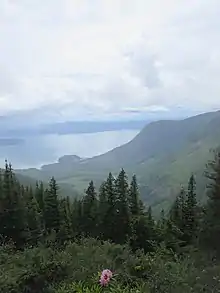Olympic National Forest
Olympic National Forest is a U.S. National Forest located in Washington, USA. With an area of 628,115 acres (2,541.89 km2), it nearly surrounds Olympic National Park and the Olympic Mountain range. Olympic National Forest contains parts of Clallam, Grays Harbor, Jefferson, and Mason counties. The landscape of the national forest varies, from the temperate Olympic rain forest to the salt water fjord of Hood Canal to the peaks of Mt. Washington.
| Olympic National Forest | |
|---|---|
 | |
 | |
| Location | Washington, USA |
| Nearest city | Quinault, WA |
| Coordinates | 47°48′35.9″N 123°4′0.2″W |
| Area | 628,115 acres (2,541.89 km2)[1] |
| Established | February 22, 1897[2] |
| Governing body | U.S. Forest Service |
| Website | Olympic National Forest |
Annual precipitation averages about 220 inches (5.6 m), giving rise to streams such as the Humptulips River.
Olympic National Forest was originally created as Olympic Forest Reserve in 1897, then renamed to Olympic National Forest in 1907. A 1993 Forest Service study estimated that the extent of old growth in the Forest was 266,800 acres (108,000 ha).[3] It is administered in two ranger districts: the Pacific Ranger District on the west side of the Olympic Peninsula, and the Hood Canal Ranger District on the east side.
Forest headquarters are located in Olympia, with ranger district offices in Forks, Quinault, and Quilcene. The former office in Hoodsport closed in 2005, and now houses a local Chamber of Commerce, which still sells Northwest Forest Passes.
Other Washington towns near entrances of the forest include Port Angeles, Sequim, and Amanda Park.
Points of interest

Wild Olympics
The Wild Olympics campaign is an effort to designate additional areas on the Olympic Peninsula as protected.
Under a bill introduced by United States Senator Patty Murray in January 2014 logging on an additional 126,554 acres (20%) of the Olympic National Forest's lands would be disallowed under the creation of nine new wilderness areas and expansion of the five existing ones. Wild and Scenic River designations would extend to 19 rivers, including those originating in the Olympic National Park, such as the Quinault, Hoh, Elwha, and Hamma Hamma, and some that do not, like the Middle Fork of the Satsop River.[4][5] According to The Oregonian, "the wilderness designation would permanently protect old growth and ancient forest habitat throughout the region. The wild and scenic rivers designation would add federal recognition to the outstanding river systems on the peninsula, protecting them as a source of clean drinking water and helping to keep Puget Sound clean for generations. This designation does not restrict private property rights."[6]
Like the Northern Spotted Owl controversy two decades earlier,[7] the action has met opposition from some residents on and near the Olympic Peninsula who see it as a threat to their livelihoods. Handmade "Stop Wild Olympics" signs can be seen in the Aberdeen area and on the peninsula, expressing displeasure,[5][8] and an opposition group, Working Wild Olympics, was set up in 2011.[9] The effort has the support of dozens of "major hunting and fishing organizations" who see it as a way to sustain elk, salmon and other fish.[10][11][12] Debate on the topic in 2014 has included community meetings drawing hundreds of individuals on both sides, and full-page advertisements in local newspapers.[13]
An episode of This American Land concerning the Wild Olympics proposal showed nationally on PBS in 2014.[14]
The Wild Olympics Wilderness and Wild and Scenic Rivers Act was reintroduced in 2019 as H.R.2642 and received a hearing in the House Natural Resources Subcommittee on National Parks, Forests, and Public Lands.[15]
References
- "Land Areas of the National Forest System" (PDF). U.S. Forest Service. January 2012. Retrieved June 30, 2012.
- "The National Forests of the United States" (PDF). ForestHistory.org. Archived from the original (PDF) on March 11, 2012. Retrieved April 2, 2018.
- Bolsinger, Charles L.; Waddell, Karen L. (1993), Area of old-growth forests in California, Oregon, and Washington (PDF), United States Forest Service, Pacific Northwest Research Station, Resource Bulletin PNW-RB-197
- Ollikainen, Rob (January 18, 2014), "Forestry group opposes Wild Olympics legislation introduced by lawmaker", Peninsula Daily News, Port Angeles, Washington
- Ahearn, Ashley (January 17, 2014), "Legislation Revived To Protect 126,000 Acres Of Olympic Peninsula", KUOW-FM, Seattle, Washington
- "Wild Olympics, scenic rivers act introduced in Congress". OregonLive.com. 4 June 2015. Retrieved 18 April 2016.
- Bruscas, Angelo (May 11, 2012), "Wild Olympics — not much middle ground", The Daily World, Aberdeen, Washington,
The first part of the event featured 30-minute presentations from the Wild Olympics campaign and from the group opposed to it, Working Wild Olympics...a retired logger...said the proposal "totally ignores the last 20 years of what has happened here on the Harbor" after the federal 1994 Northwest Forest Plan curtailed logging in an attempt to preserve spotted owl habitat.
- "More anti Wild Olympic signs going up locally", KXRO, Aberdeen, Washington, September 30, 2013, archived from the original on August 21, 2019
- Friederich, Steven (September 23, 2011), "Working Wild Olympics -- Timber workers have their say", The Daily World, Aberdeen, Washington,
The Working Wild Olympics Coalition, made up of timber interests and supporters, was convened to directly oppose the Wild Olympics Campaign, made up of conservation and recreation groups who want to see more protections brought on areas surrounding Olympic National Park.
- "Wild Olympics have Olympic Peninsula hunting and fishing support", KXRO, Aberdeen, Washington, February 5, 2014, archived from the original on August 21, 2019
- "Sportsmen for Wild Olympics announce new endorsements & video", KBKW, Aberdeen, Washington, February 5, 2014, archived from the original on November 29, 2014
- "Endorsements". Wild Olympics Campaign. Retrieved 2019-08-21.
- Couhig, Mark St.J. (March 20, 2014), "Wild Olympics debate heating up", Sequim Gazette, Sequim, Washington
- "Wild Olympics Campaign featured on "This American Land"", The Conservation Alliance, July 9, 2014
- Kilmer, Derek (2019-07-10). "H.R.2642 - 116th Congress (2019-2020): Wild Olympics Wilderness and Wild and Scenic Rivers Act". www.congress.gov. Retrieved 2019-08-21.
